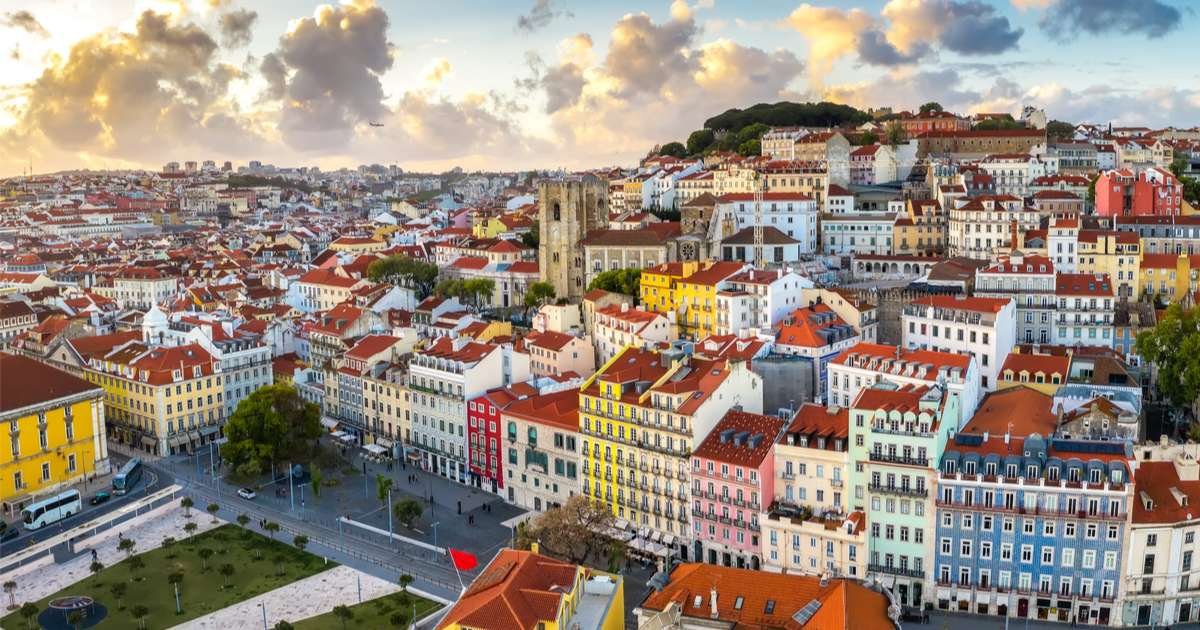Lisbon's top 19 districts.
A history of Romans and Moors, royalty and earthquakes- from revolutions to rebirths, Lisbon has seen it all. The center of the city fits into a radius of just a few kilometers, but within this intimate invisible boundary exists a multifaceted city of countless personalities.
The neighborhoods or bairros flow seamlessly into one another, with some areas composed of just a few streets, but their characters are strong and unique. The distinct flavors and atmospheres of each area are tied together almost always by their unifying trait of color and azulejos.
Our list of the top 19 districts of Lisbon explores the must-see neighborhoods and touches on what makes them special. With the exception of a few areas, all neighborhoods are central and reachable on foot or with a short ride using Lisbon's public transportation.
Let's dive in!
Other Recommended Articles:
50 Best Things to Do in Lisbon
Public Transportation in Lisbon
Recommended Hotels in Lisbon
Things to Do with Kids in Lisbon
Best Restaurants in Lisbon
Shopping in Lisbon
1. Alfama
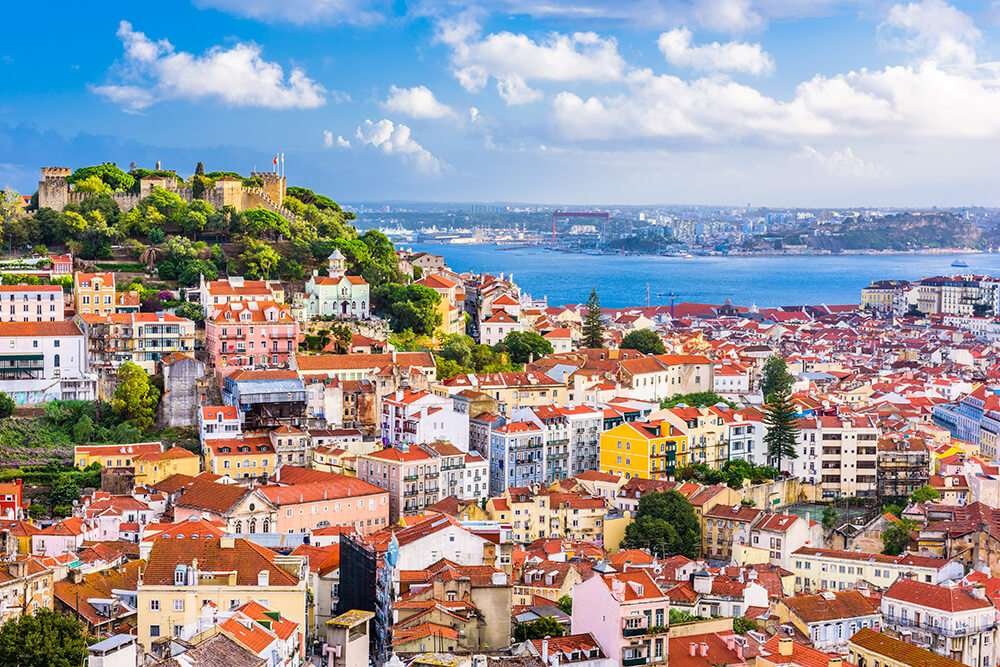
Step into the oldest neighborhood in Portugal’s capital and one of the oldest in all of Europe! The colorful cluster of homes are tied together by winding cobblestone streets that when seen from above appear as a maze. Alfama hosts a few of the city’s best viewpoints, called miradouros, where visitors have the chance to capture an iconic photo of the terracotta tiled roof tops of the centuries old buildings which cascade toward the Tejo.
Immerse yourself in the charming quarter and stroll past the São Jorge Castle, the Lisbon Cathedral, dimly lit tavernas where fado floats nightly from the windows or past residents who have owned property here for generations, selling homemade ginjinha (traditional cherry liquor) from beside their front doors. Long lines of fresh laundry dance overhead and various details in the architecture still exist that remind visitors that this was once the Moorish district. We strongly suggest exploring Alfama on foot, but if you grow tired, the yellow tram rumbles directly through the heart of the neighborhood.
Alfama is undeniably one of the most touristy neighborhoods in Lisbon- but don’t be deterred. It’s a fantastic place to visit year-round and in June it welcomes the biggest parties in the city where thousands gather in the streets to celebrate the Santo António festival, drinking beer from plastic cups and chomping down on grilled sardines.
- For more insights, visit our dedicated page about Alfama and its top attractions.
2. Baixa
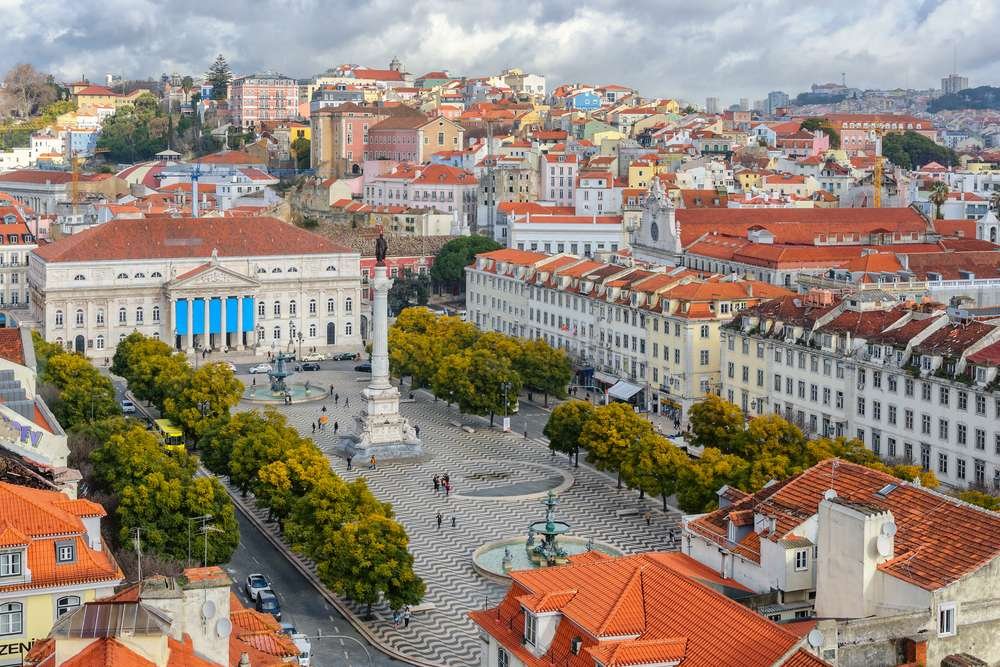
The center and heart of the city, Baixa is the home to cultural landmarks, stunning Pombaline style architecture, massive boulevards laid out on a grid system and the waterfront Praça do Comércio. The defining features of this area are that it is flat and “new,” in that all of the area was rebuilt in the 18th century.
Lined with pastel colored buildings, the Praça do Comércio is a perfect place to start a sight-seeing tour of Baixa. Cross beneath the ceremonial Rua Augusta Arch and walk along the pedestrian only shopping street of Rua Augusta. You'll pass more restaurants and hotels than you can keep track of before arriving at the Santa Justa Lift. Continue a bit farther and the streets open up to Rossio Square, the gathering and meeting place in “downtown” Lisbon. Here the enchanting Rossio station is located which carries travelers to Sintra for romantic day trip getaways.
Baixa is a fantastic option for booking hotels in the center of Lisbon as its easy to reach all forms of public transportation, there is an abundance of accommodations here, from Lisbon's top 5 star hotels to hotels for large groups and events and the shopping options are greatest!
3. Belém

Although Belém is slightly outside, it's still easy and reach and here you can expect a cultural district which dedicates itself to the 15th century Age of Discovery Portugal spearheaded.
Various manueline-style monuments and museums line the river’s edge which celebrate Henry the Navigator and Vasco da Gama, two men who helped shape the future for both Portugal and the world through navigation. Cultural landmarks such as Belém Tower, Monument to the Discoveries and the Jerónimos Monastery all remind visitors of the wealth the country acquired from new trade routes.
With a handful of museums which focus on art, culture, technology, military, ships, electricity and even the evolution of transportation in coaches, there is something here for everyone. Not in the mood for a museum? Then take a stroll through their picturesque downtown, visit the Ajuda Palace, stop by the botanical gardens and be sure to grab a custard tart at the most famous bakery in all of Portugal, Pastéis de Belém.
With a stop on the coastal train line, connecting Lisbon to the upscale Cascais, Belém is a great location for those on their way to the beach or curious in exploring the opposite banks of the Tejo and planning to travel by ferry.
4. Alcântara

What draws many to Alcântara is the ultra-cool LX Factory. The abandoned warehouse complex turned cultural art hub is a top destination on most peoples’ list when they visit Lisbon. But LX Factory isn’t the only part of this neighborhood that has experienced a resurgence in recent years.
Alcântara, located directly on the river’s edge, is becoming increasingly hip, hosting a growing number of cafes, bars, sushi spots, designer stores and creative co-work spaces. Tourists come to enjoy a wine or meal at Docas de Santo Amaro, a charming waterfront dock with various dining options- a dream for foodies.
Despite the changes it’s experiencing, Alcântara still holds on to its essence of remaining a more-or-less traditional neighborhood. A growing number of expats are settling here as well as digital nomads- all of whom are welcomed by the Portuguese community. In between the new businesses popping up, you can easily find a neighborhood pastelaria where large plates of traditional Portuguese food are served at low prices and espresso is less than a euro a cup.
5. Avenida da Liberdade
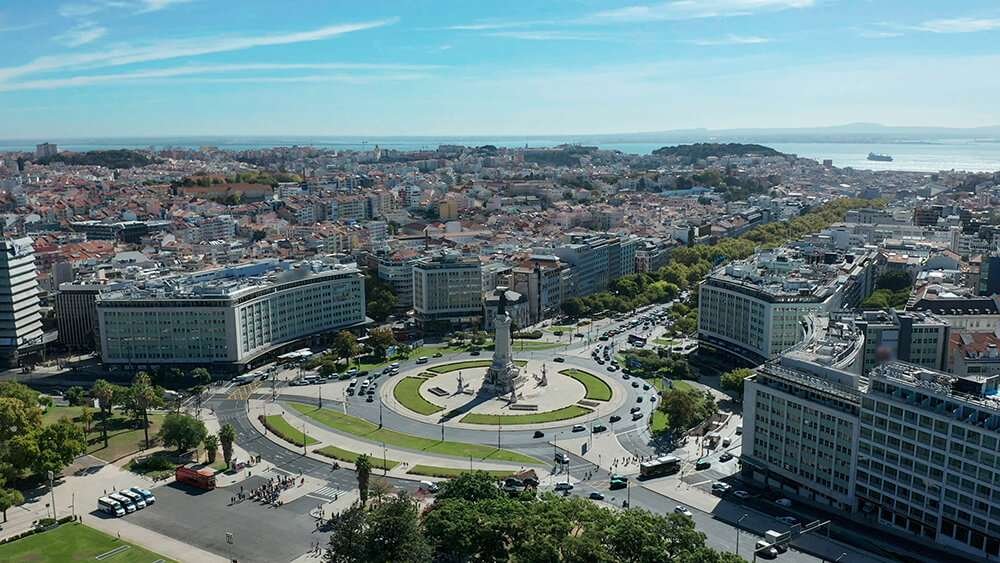
Whether you decide to begin at the top, at Parque Eduardo VII or at the bottom, just beyond Restauradores Square, the almost two kilometer long Avenida da Liberdade offers a stunning walk through the center of Lisbon. Inspired by the grandeur of Champs-Élysées in Paris, the avenue was built to be wide, aesthetically pleasing and to comfortably accommodate pedestrian foot traffic.
Built in the 19th century, the grand avenue has become home to a string of five star hotels, a shopping destination in Lisbon and unbeatable dining experiences. If you’re not looking for any of that, you can expect a beautiful amble under canopy trees and past adorable kiosks where people sit beside fountains and sip on underpriced wine. Look down, and you will discover an artistically patterned black and white cobblestone sidewalk with a design that continuously changes.
6. Bairro Alto

Sitting atop one of Lisbon’s highest hills, Bairro Alto has certainly earned its name. The trendy (with a splash of gritty) neighborhood is known for its views, fusion foodie finds, street art, alternative shopping and its nightlife, with some of Lisbon's best bars located here. The artsy area transforms into a thriving quarter of energy when the sun sets, with bar after bar offering drink discounts, specialty cocktails, a variety of music and dance choices and tiny little hole in the wall spots, waiting to be stumbled into.
The bohemian Bairro Alto often attracts a younger crowd, with many hostels, bars and parties catering primarily to the 30s and under crowd. This is not to say there isn't something for everyone, but generally you can expect a bit of a wilder night when you venture into the area.
During the day it's a different story, with various cultural and historic landmarks to visit, including the São Roque church, Praça de Luís de Camões and the São Pedro de Alcântara miradouro. The neighborhood began to bloom after the Carnation Revolution of the 1970s, when the dictatorship fell and freedom of intellect and creativity blossomed. That energy is still very much alive and apparent in Bairro Alto and a stroll through her streets will reveal this to any visitor.
- Be sure to read our guide to Nightlife in Lisbon when planning your perfect night out on the town.
7. Chiado
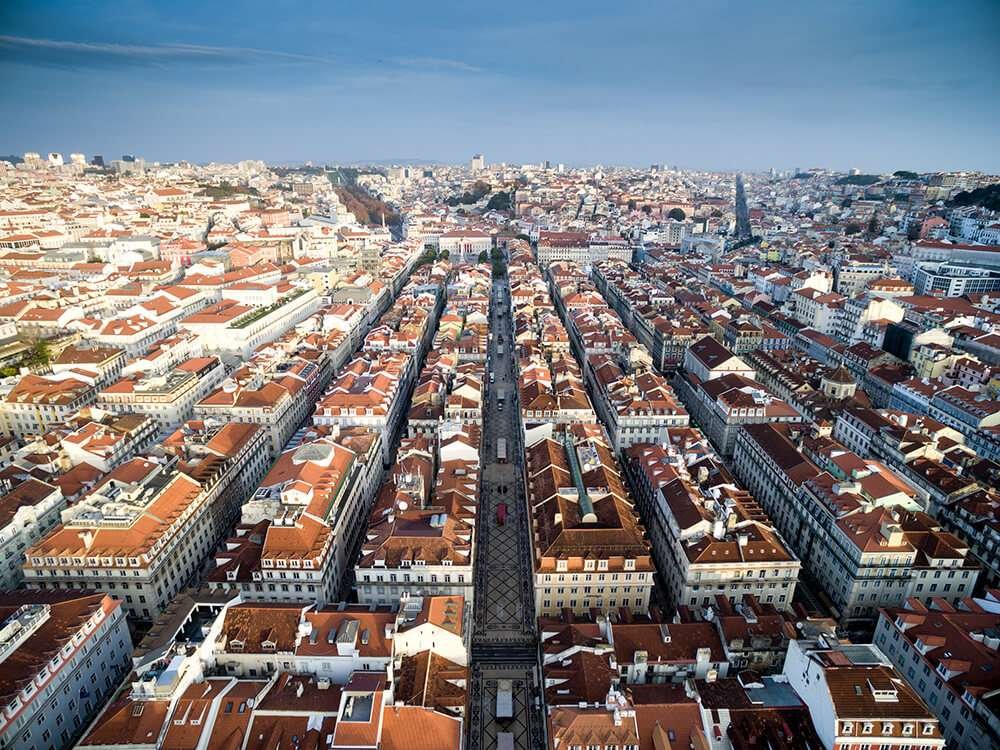
Consistently rated as one of the most popular neighborhoods with travelers to Lisbon, Chiado offers the best of the best. Begin your adventure into Chiado with a walk up the shopping street, Rua do Carmo, which is closed to automobile traffic. Pass by endless shopping opportunities of affordable brands, classy theaters, Michelin star restaurants, famous literary cafes, boutique designers and one of the most stunning landmarks in the city, the Carmo Convent.
The Carmo Convent, located in the Largo do Carmo square, sits beside jacaranda trees which blossom in bright lilac. What makes this convent spectacular is that it was half destroyed during the earthquake of 1755, but today you can walk through the open air style archaeological museum and admire the blue sky above. Aside from the convent, Chiado itself also experienced a traumatic disaster as a fire raged through the neighborhood in the 1980s. Due to that, many of the buildings here are a mix between 19th century and modern, but nonetheless grand in their own right.
The central location of Chiado makes it easy to reach and almost all forms of public transportation are just a few meters walk in any direction. Nestled between Baixa and Bairro Alto, you can expect this area to get crowded and full of energy, day or night.
- Home to the best boutique hotels in Lisbon, Chiado has no shortage of places to stay.
8. Cais do Sodré
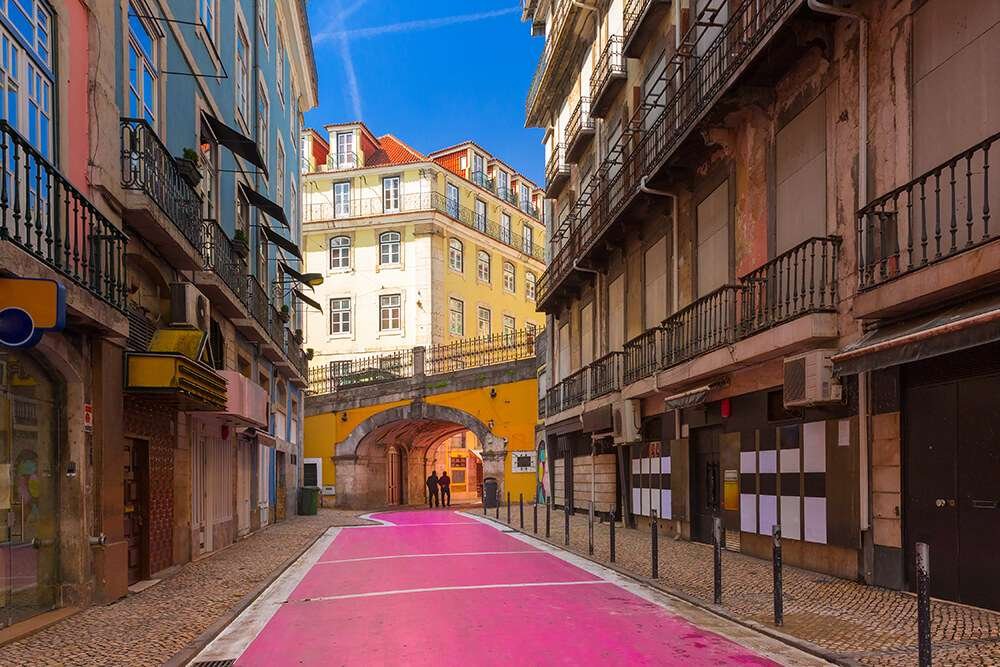
Cais do Sodré has much to offer visitors, from the massive Time Out Market to the hopping bar avenue Pink Street to its various desirable cafes and co-work spaces, rooftop restaurants and funky hotels. The neighborhood, located just opposite the river is home to the main station for the coastal train line and is criss-crossed by the tram line, the trolley cars and many city buses. Not to mention, tuk tuk drivers line up outside Time Out Market, eager to tour visitors around the city or drop them off at their next destination. Cais do Sodré also has a ferry terminal for those interested in visiting the other side of the Tejo.
One of Lisbon's foodie spots by day and an up-and-coming drinking district by night, Cais do Sodré is always full of tourists and locals. Walking the wide neighborhood streets you would never know that this was once a sketchy district, popular with sailors and those supporting the interests and dare we say, passions of sailors. Today you won’t find anything that resembles its past life, but get your cameras out because between the architecture, parks and street art, there is still much to capture.
9. Graça and São Vicente
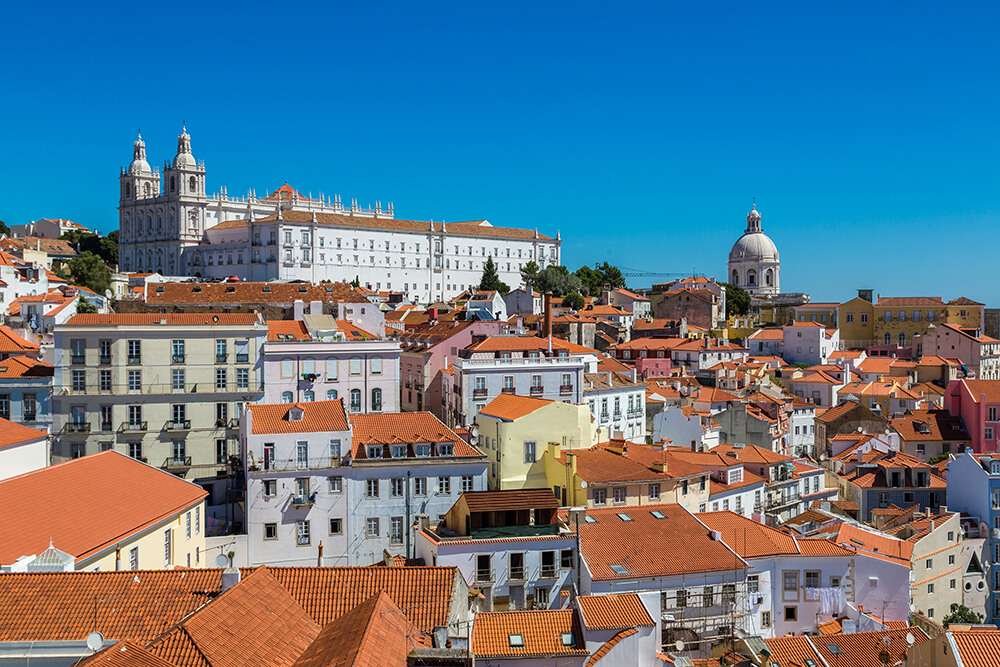
Just beside Alfama are Graça and São Vicent, two little neighborhoods which blend with one another. Considered part of the older side of the city, they’re popular with residents and expats looking to settle into local Portuguese life. Here you will find tiny streets with even tinier walkways in hilltop districts made up of a collage of tiled buildings all along narrow streets which wind in every direction, opening up to unforgettable river views. The hills are extremely steep to climb but lucky for visitors, the tram line rambles through the neighborhoods. Despite being centrally located, Graça and São Vicent remain authentic and you can expect traditional eateries and low prices here.
Some of the must see historical landmarks in this neighborhood are the Pantheon and the São Vicente Church. Both structures pop out above the skyline and offer a glimpse into Portugal's past. Another sought out attraction is Feira de Ladra, a street market filled with vintage and second hand items which takes over a couple of streets every Tuesday and Saturday. For the most memorable experience make sure you visit the Graça miradouro, located atop one of the highest points in the city. From here you can look out at the entire city, stretching across the rolling and falling hills of neighborhoods below until your eye meets the red 25 de Abril bridge. Graça is a place to explore without any particular destination in mind.
- If you desire to stay in one of Lisbon's historic hotels, these neighborhoods are home to many on our top list.
10. Príncipe Real
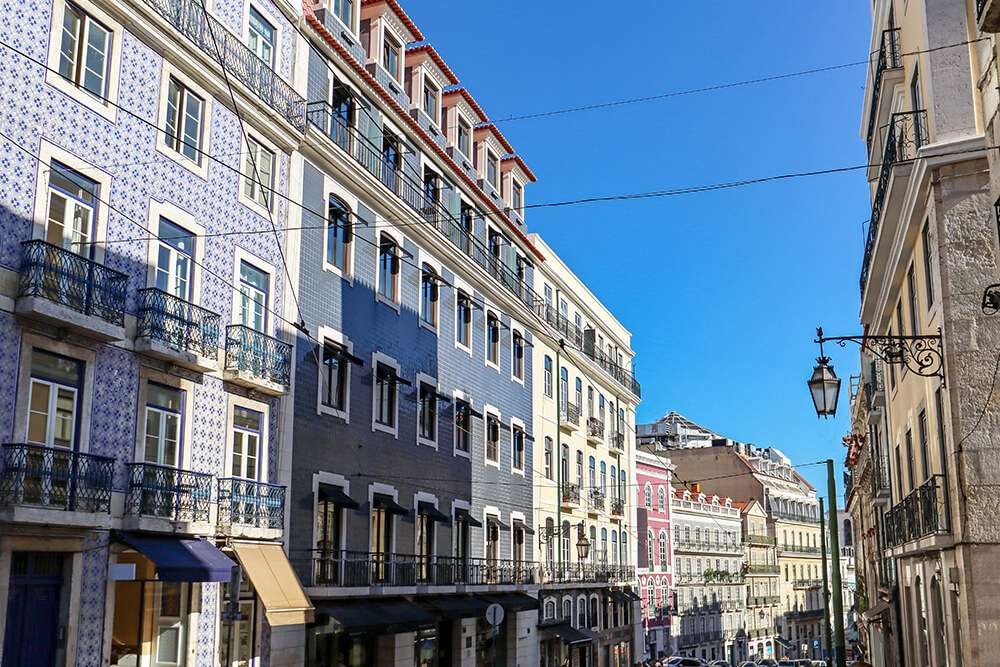
→ Just beside Bairro Alto is Príncipe Real, a beautiful neighborhood which has all of the fun of its crazy neighbor, minus much of the wild. Here you will find more gourmet restaurants than bars, with a higher density of boutique designers as opposed to tattoo parlors. While you'll find many residents in this desirable neighborhood, with a name that translates to “royal prince,” you'll also find that it hosts various hotels.
In the center of the neighborhood is a stunning park with an adorable cafe at its heart. Two smaller kiosks sit on opposite sides under the canopy of trees and attract customers day and night, sipping espressos and aperol spritz. We suggest grabbing a cup of coffee and walking to the miradouro in the neighborhood that overlooks the city.
Many international and Portuguese artists are drawn to the energy of Príncipe Real, so expect art stores, murals and galleries among the colorful streets of grand buildings you wander down. If you're in the area on a Saturday, stop by the farmers market where local producers sell their produce, most of which is organic.
→ Another added bonus- many of Lisbon's best hotels with pools can be found here.
11. Estrela
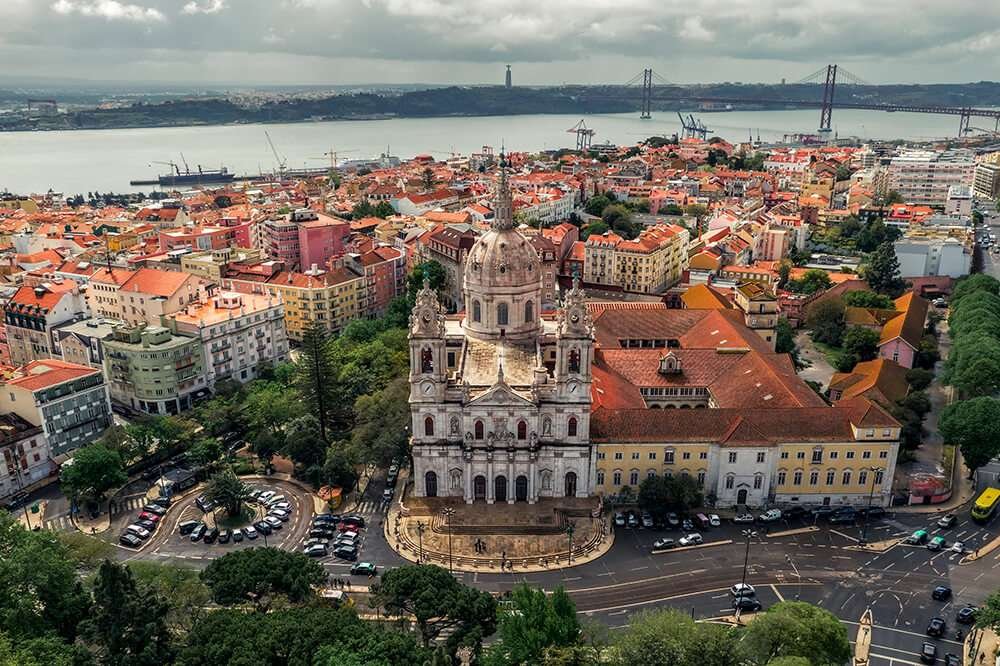
The upscale neighborhood of Estrela is most famous for its stunning park, Jardim da Estrela, located directly across from its equally gorgeous Basilica Estrela. Estrela has cute family run eateries and shops serving everyday needs, but it's generally not a neighborhood known for its nightlife or tourist attractions.
Frequented mostly by locals and those willing to trek up the hill to visit the park, the neighborhood is generally quiet. When the weather is good, which is most of the year, the park fills up with those coming to admire the exotic foliage while they sip on a drink at one of the two kiosks. Another park, less popular than Estrela but fantastic in its own right, is Tapada das Necessidades. It's less busy but offers a quiet and green oasis to relax in and escape what hustle and bustle you may find in Lisbon, which- is not much.
12. Bica

Bica is one of those neighborhoods that truly exists within blurred boundaries. Nestled right between Santos and Cais de Sodré, the tiny cluster of streets hosts a handful of bars, restaurants and shops. A buzzing crowd comes here to have dinner and cheap drinks before a night out. Sit down in a streetside cafe and order a meal of petiscos, the traditional small plate appetizers which allow you to sample a range of Lisbon’s culinary delights or grab a coffee at one of Lisbon's top cafes which has been ethically sourced.
The architecture in Bica is beautiful, often defined by tall traditional buildings coming close enough together only to allow for tight walking paths in between. Little balconies jut out from the fronts and overlook the tram line which passes by beneath.
13. Lapa

One of Lisbon's most affluent neighborhoods, Lapa is the host of villas and embassies, consulates and five star hotels. Behind gates you can sneak a peek at mansions that appear to be palaces sitting side by side with some of the most incredible apartment buildings in the city.
Luxury is the theme of Lapa, and while there are some bars and restaurants here, the neighborhood generally remains quiet and out of the way for tourist traffic. Lapa is ideal if you are looking to have a walk to simply admire the architecture of the area.
- A honeymoon is best experienced at one of the most romantic hotels in Lisbon, with many located in or around Lapa.
14. Santos
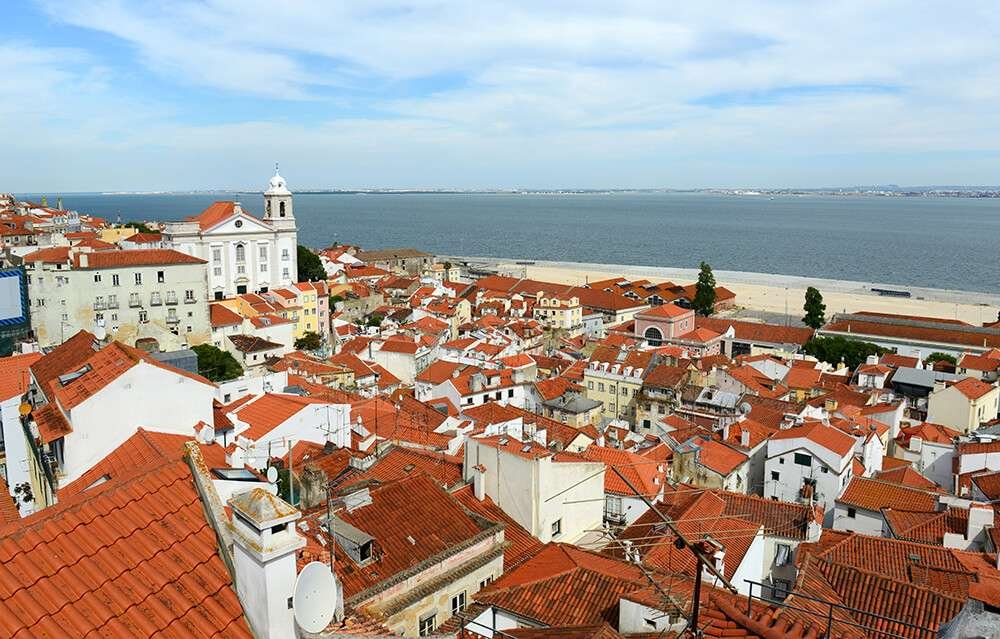
Just below the embassy heavy neighborhood of Lapa lays Santos, a more local area which has in recent years attracted expats looking for a quiet out-of-the-center life. Santos is the best of both worlds, simultaneously old and new, with trendy international cafes serving top-notch instagrammable vegetarian food sitting beside hole in the wall pastelarias and grilled fish diners. Many warehouses and buildings in the area are being renovated and turned into art galleries, dance studios and co-working spaces. These developments continue to attract more artists, expats and digital nomads who live side by side with older Portuguese residents, giving the neighborhood an eclectic flair.
Santos can best be described as quiet and local, a place for a great meal of fresh food off the beaten tourist path. Santos has its own coastal train station and has easy access to most forms of public transportation, making it a nice option for booking hotels. The month of June is the only time you won't find Santos as a sleepy little corner of the city, as the saint’s festivals begin and the streets fill to the brim with people dancing and eating food straight from street grills.
15. Campo de Ourique

At what could be considered the top of the city and the boundary limit before you “exit” the central neighborhoods, you will discover Campo de Ourique. In recent years it has become popular with young middle class families and the atmosphere either reflects that or is what attracted them to settle here. Quaint restaurants, boutiques, inviting cafes, adorable childcare stores, a diversity of fresh food markets, the beautiful park Jardim da Parada and a main tree lined street are all bonuses of the Campo de Ourique neighborhood.
A visit to the neighborhood calls for a stop at the Mercado de Campo de Ourique, a miniature version of Time Out Market in Cais de Sodré. You won't find the crowds here or prices for tourists, rather a fresh food market, vendors and skilled workers catering to whatever your needs are and many second hand shops.
The neighborhood has the rare features of being both flat and on a grid and combines Lisbon's old and new, with historic buildings side by side with art deco style apartments and cafes. If you’re traveling with children and want a neighborhood that's easy to explore and suits the needs of the family, this is it! An added bonus- you can take the yellow tram here as the Mercado is one of the last stops before it begins the full route again.
16. Intendente, Anjos and Arroios

The three neighborhoods of Intendente, Anjos and Arroios usually are passed over by short term visitors to Lisbon, but have nevertheless become some of the most popular neighborhoods for young people to settle who are relocating.
In past decades these districts have hosted many immigrant families which has resulted in a quilted fabric of cultures; where Nepalese restaurants share the block with Indian owned electronic shops, Chinese markets, Korean BBQs, Brazilian salons, Turkish hostels and African owned and operated businesses. The neighborhoods have transformed to host the working class of Lisbon and they have become a hot spot for food culture, alternative bars, art events and cheap shopping. They attract the artsy youth of the city and low rents and access to most of the public transportation lines makes them a desirable place to live.
17. Beato and Marvila
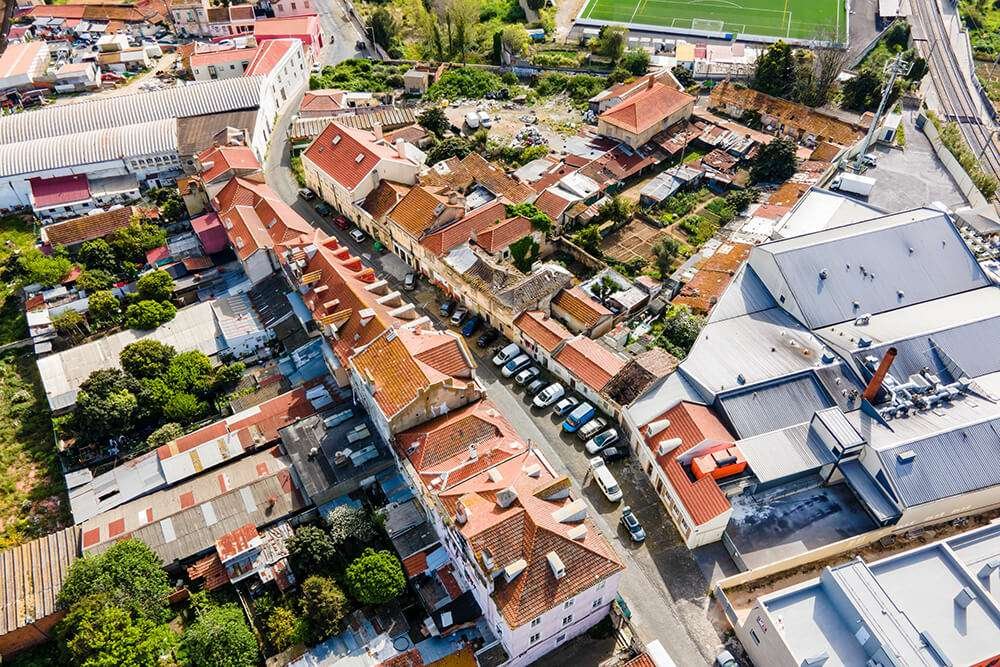
We’ve lumped these two neighborhoods together as they are small and slightly outside of the city center. While still easy to reach by car or bus, they don’t attract foot traffic as the other neighborhoods do. However, a short ride away awaits two very cool and up and coming areas.
In Beato and Marvila many old warehouses which were left empty for ages have been repurposed as art studios, galleries, co-work spaces and event halls. Some breweries have also relocated here, such as Musa, and there is an intimate community coming together to recreate an energy for these neighborhoods. Not to mention, the very popular National Museum of the Azulejo calls this area home and no visit to Lisbon is complete without learning about the tiles that tell the city’s story.
18. Mouraria
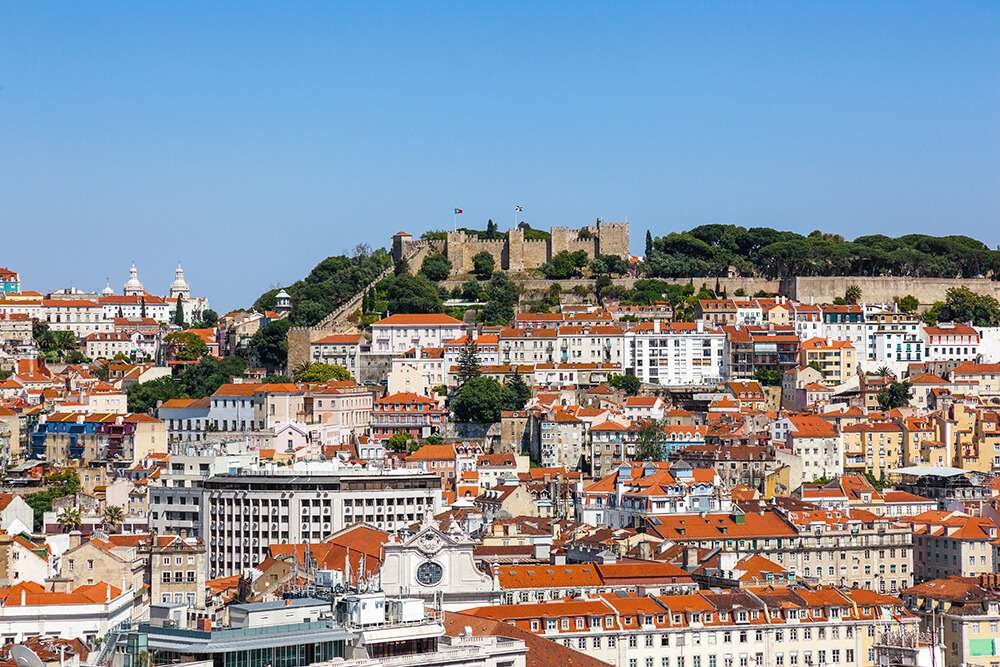
In Mouraria, an old moorish district, you will find a multicultural blend of the different nationalities living in Lisbon. For centuries it has been one of the most diverse neighborhoods in the city and a short stroll down the sidewalk will expose you to multiple languages being spoken. Here you will find a wide range of shopping, from big to small needs as well as some of the best restaurants in the city, whether you're craving dumplings from Macau, curry from Pakistan or a big dish of spicy seafood from Mozambique. The center of the neighborhood is Martim Moniz, a big square where people gather and meet. Public transportation is easy to come by in Mouraria and many budget friendly hotels are located around the square.
19. Parque das Nações
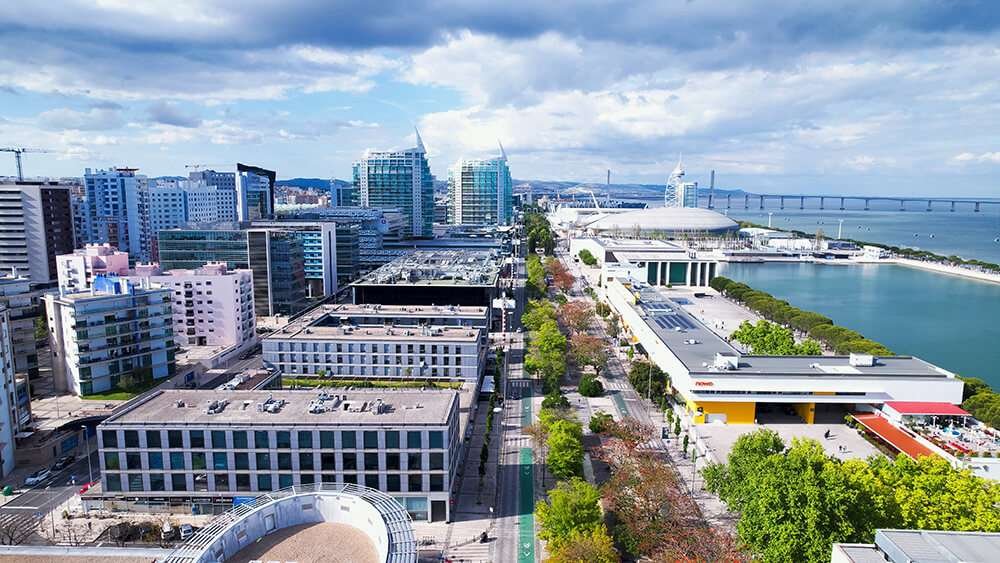
Step into Lisbon’s most modern district, constructed for the 1998 World Exposition that Lisbon hosted. Parque das Nações is the farthest neighborhood on our list from the center of the city, but it's definitely worth a visit when you come to Lisbon. Bus number 728 runs from Lisbon’s center directly to Parque das Nações and takes less than a half hour. Some of the highlights of this neighborhood include the Oceanario, the Pavilion of Knowledge science museum, the Portugal Pavilion and the Orient train station.
The contemporary architecture here is in stark contrast to that which you find in Lisbon, with many high rise buildings, sleek restaurants, giant shopping malls and ultra modern glass structured hotels. A long walkway was created beside the river so people could stroll, bike, rollerblade or scooter and enjoy the beautiful view. Don’t feel like walking? Jump on the cable car, Telecabine, and enjoy a ride 30 meters above, soaking in the sparkling view.
Lisbon is not a city to be rushed. She operates at a slow pace and taking the time to appreciate her colors, textures, smells and sound will help you to gain a better understanding of her centuries old soul. The neighborhoods in our list all offer a small slice of life in the city, with their quirky traits and vitality in difference. You’d be hard pressed to find someone who didn't love Lisbon after exploring all that she has to offer.
The key to experiencing the best of Lisbon is knowing where to stay! Send us a message and allow us to help you and your group with your hotel reservations and accessing discounts.
Leave us a comment below and let us know which neighborhoods were your favorite and what you discovered there!
You are currently viewing a placeholder content from Default. To access the actual content, click the button below. Please note that doing so will share data with third-party providers.
More Information
